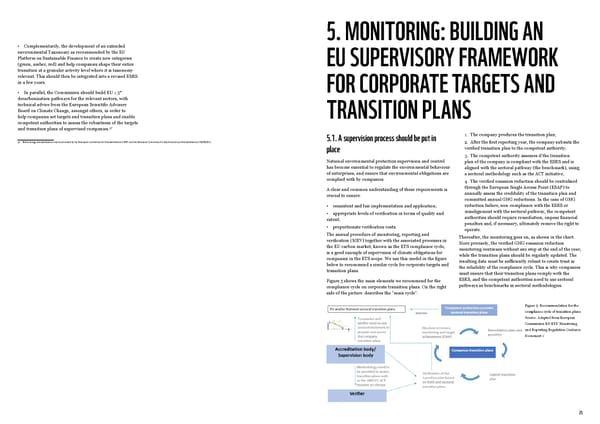25 • Complementarily, the development of an extended environmental Taxonomy as recommended by the EU Platform on Sustainable Finance to create new categories (green, amber, red) and help companies shape their entire transition at a granular activity level where it is taxonomy- relevant. This should then be integrated into a revised ESRS in a few years. • In parallel, the Commission should build EU 1.5° decarbonisation pathways for the relevant sectors, with technical advice from the European Scientific Advisory Board on Climate Change, amongst others, in order to help companies set targets and transition plans and enable competent authorities to assess the robustness of the targets and transition plans of supervised companies. 57 57 Methodology standardisation may be provided by the European Committee for Standardization (CEN) and the European Committee for Electrotechnical Standardization (CENELEC). 5. MONITORING: BUILDING AN EU SUPERVISORY FRAMEWORK FOR CORPORATE TARGETS AND TRANSITION PLANS 5.1. A supervision process should be put in place National environmental protection supervision and control has become essential to regulate the environmental behaviour of enterprises, and ensure that environmental obligations are complied with by companies. A clear and common understanding of these requirements is crucial to ensure: • consistent and fair implementation and application; • appropriate levels of verification in terms of quality and extent; • proportionate verification costs. The annual procedure of monitoring, reporting and verification (MRV) together with the associated processes in the EU carbon market, known as the ETS compliance cycle, is a good example of supervision of climate obligations for companies in the ETS scope. We use this model in the figure below to recommend a similar cycle for corporate targets and transition plans. Figure 5 shows the main elements we recommend for the compliance cycle on corporate transition plans. On the right side of the picture describes the “main cycle”: 1. The company produces the transition plan; 2. After the first reporting year, the company submits the verified transition plan to the competent authority; 3. The competent authority assesses if the transition plan of the company is compliant with the ESRS and is aligned with the sectoral pathway (the benchmark), using a sectoral methodology such as the ACT initiative; 4. The verified emission reduction should be centralised through the European Single Access Point (ESAP) to annually assess the credibility of the transition plan and committed annual GHG reductions. In the case of GHG reduction failure, non-compliance with the ESRS or misalignment with the sectoral pathway, the competent authorities should require remediation, impose financial penalties and, if necessary, ultimately remove the right to operate. Thereafter, the monitoring goes on, as shown in the chart. More precisely, the verified GHG emission reduction monitoring continues without any stop at the end of the year, while the transition plans should be regularly updated. The resulting data must be sufficiently robust to create trust in the reliability of the compliance cycle. This is why companies must ensure that their transition plans comply with the ESRS, and the competent authorities need to use sectoral pathways as benchmarks in sectoral methodologies. Figure 5: Recommendation for the compliance cycle of transition plans Source: Adapted from European Commission EU ETS ‘Monitoring and Reporting Regulation Guidance Document 1’
 Corporate Sustainability & Transition Plans Page 12 Page 14
Corporate Sustainability & Transition Plans Page 12 Page 14